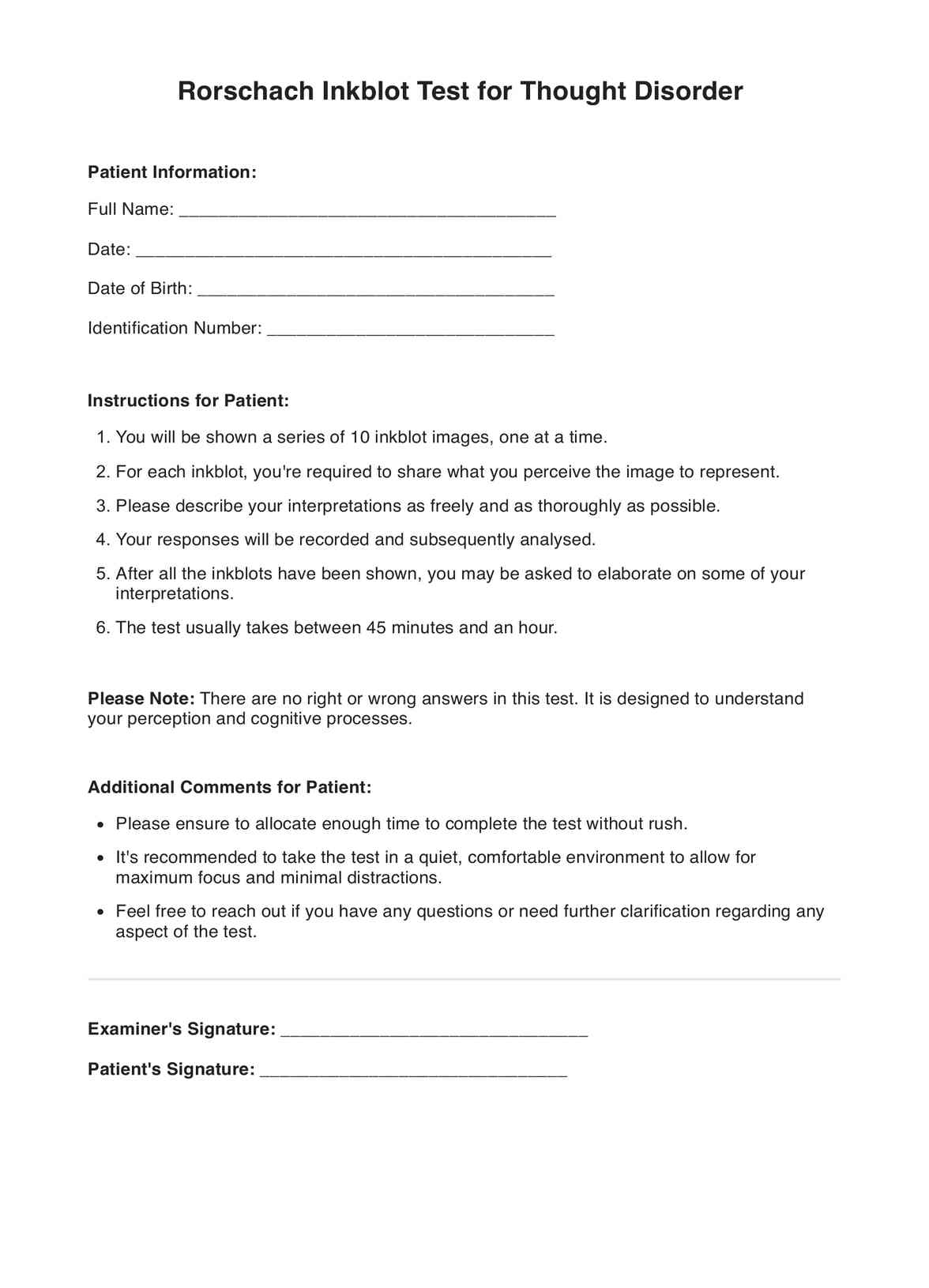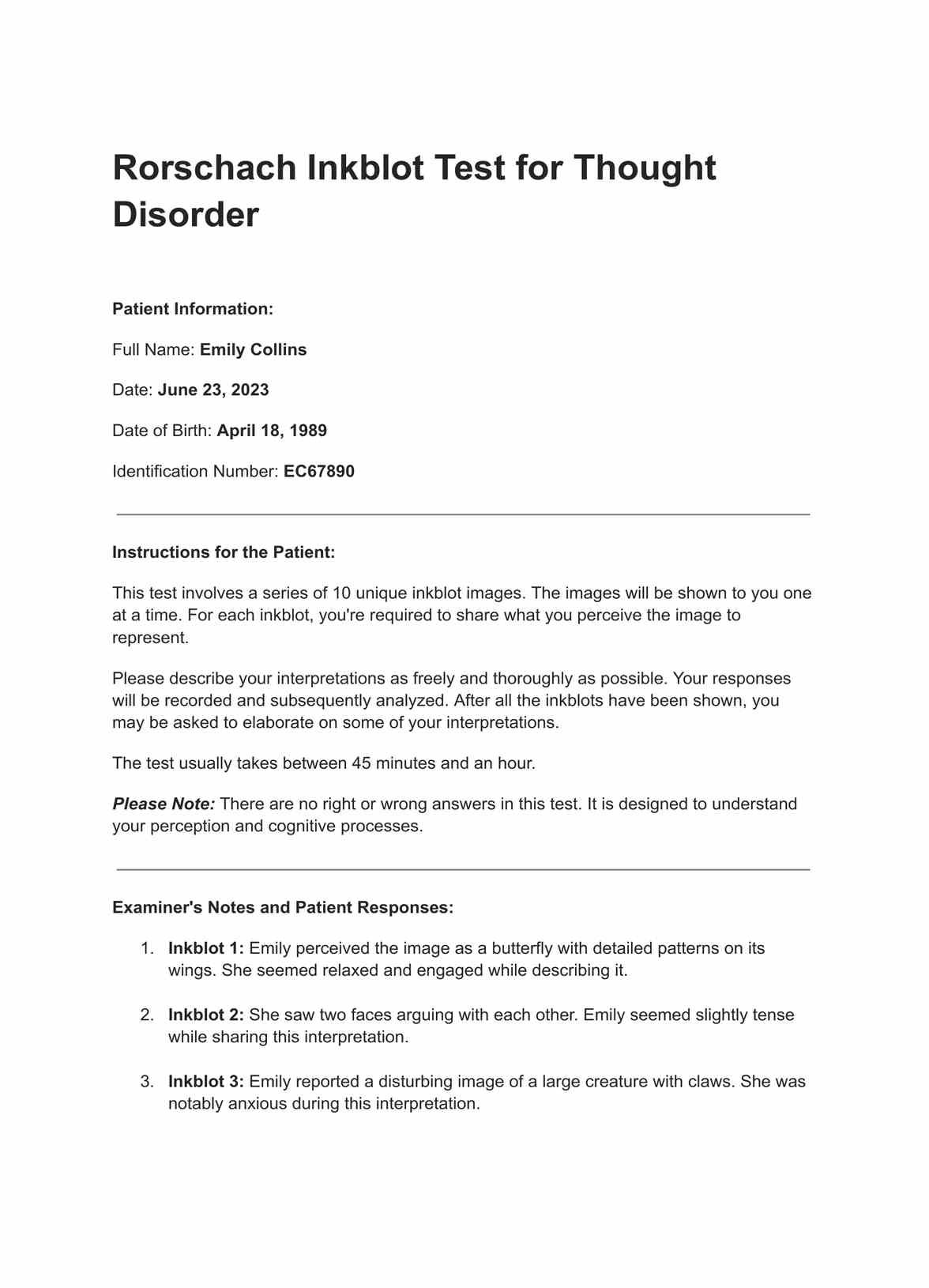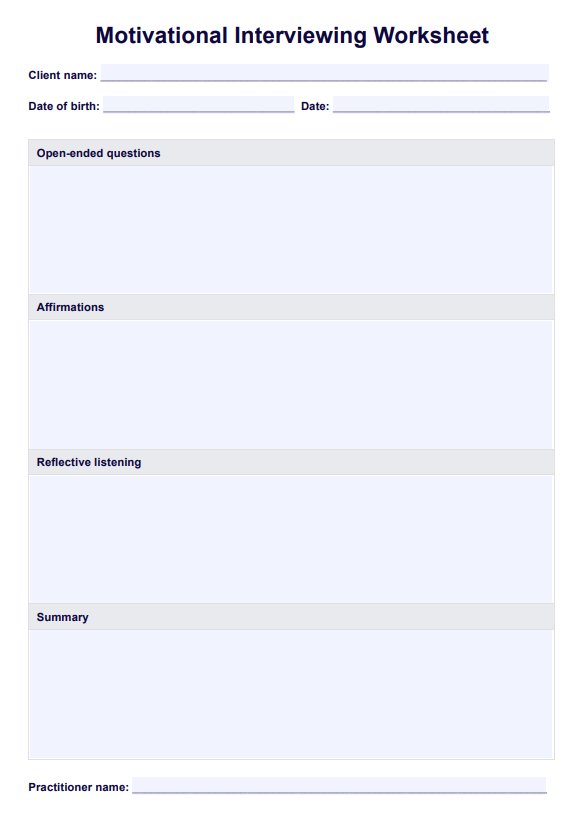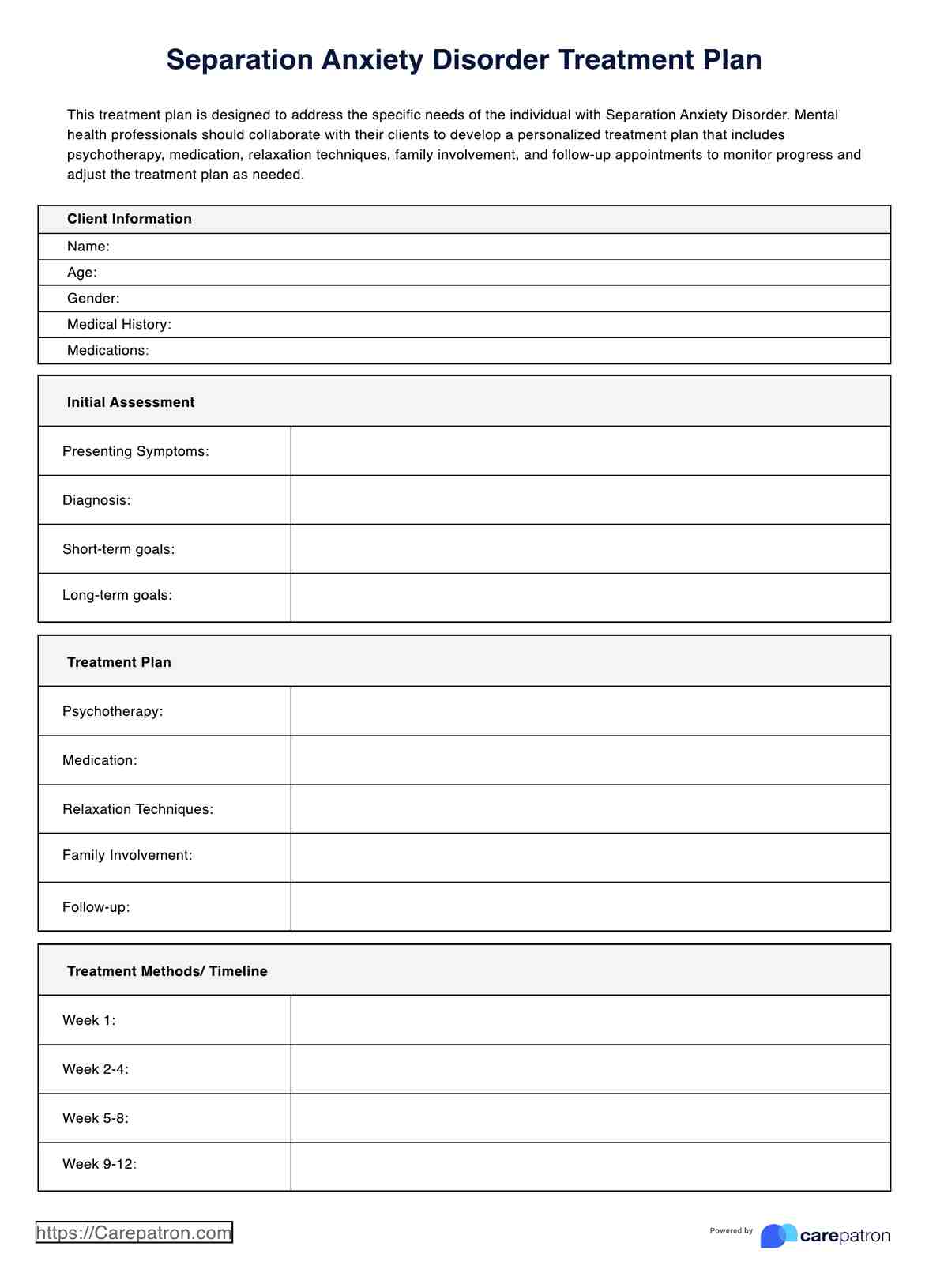Rorschach Inkblot Test for Thought Disorder
The primary purpose of the Rorschach test lies in its capacity to diagnose thought disorders marked by disruptions in thinking, attention, and communication.


What is a Rorschach Inkblot Test for Thought Disorder?
The Rorschach Inkblot Test, often referred to as the Rorschach test, is a profound psychological tool that analyses an individual's perception and cognitive process. Crafted by Swiss psychiatrist Hermann Rorschach, the test intends to penetrate the subconscious mind, an area largely inaccessible through standard conversation or observation.
The test comprises ten symmetrical inkblots, some colored and others in black and white. Each participant's interpretation of these abstract inkblots can help reveal underlying thoughts, feelings, and potential psychological issues. Using these interpretations, mental health professionals can gain unique insights into the patient's cognitive functioning and emotional state.
The primary significance of the Rorschach test lies in its capacity to identify thought disorders marked by disruptions in thinking, attention, and communication. These thought disorders often manifest as abnormal patterns of speech, including tangential speech, circumstantial speech, pressured speech, and poverty of speech. Each of these terms represents different ways in which the coherence and clarity of speech may be lost.
- Tangential speech involves responding to questions in an oblique, tangential manner, often veering off the topic.
- Circumstantial speech refers to a style of conversation where the individual tends to include unnecessary and often irrelevant details, making it difficult for them to convey their point concisely.
- Pressured speech is rapid and frenzied, commonly observed in manic episodes.
- Poverty of speech denotes limited and often monotonous speech, usually associated with depression or schizophrenia.
These speech anomalies provide critical clues to the underlying thought disorder. The Rorschach Inkblot Test enables healthcare professionals to gauge these anomalies effectively and assess the extent of thought disorder. While some patients may be able to mask their symptoms during direct questioning or observation, their responses to the inkblots can reveal hidden disturbances in their thought patterns.
Rorschach Inkblot Test for Thought Disorder Template
Rorschach Inkblot Test for Thought Disorder Example
How does this Rorschach Inkblot Test for Thought Disorder work?
The Rorschach Inkblot Test contains 10 inkblot images, presented to the individual being tested one at a time. The person's responses to what they perceive in the inkblots are recorded and subsequently analyzed. The Rorschach Inkblot Test is usually conducted using the following steps:
Step 1: Introduction to the Test
The examiner introduces the test to the individual and explains that they will present each image one at a time.
Step 2: Presenting the Inkblots
The examiner shows the individual the first inkblot and asks, "What might this be?" This process is repeated for each of the ten inkblots, ensuring the person's responses are purely their own interpretations. Some categories the examiner may use include:
- Human
- Animal
- Inanimate
- Reflective
- Paired
- Shading
- Colour
- Depth
- Symmetry
- Other specific characteristics
Step 3: Recording the Responses
The examiner records their responses verbatim as the individual describes what they see in each inkblot. Every detail, including noticeable pauses, tone changes, hesitations, or deviations in speech, such as tangential or circumstantial speech, is documented.
Step 4: Review and Elaboration
After all the inkblots have been presented, the examiner reviews the responses. They may ask the individual to elaborate on certain interpretations, particularly those that seemed rushed (indicative of pressured speech) or were unusually sparse (indicative of poverty of speech).
Step 5: Analysis of Responses
The examiner then analyses the responses, focusing on the content, the way the content was delivered, and any distinctive speech patterns. These analyses will provide insights into the individual's subconscious thoughts, emotions, and perceptions.
Step 6: Final Assessment
Based on the analysis of the responses, the examiner forms a comprehensive picture of the individual's mental state. This can aid in diagnosing thought disorders, a category of mental health issues marked by disruptions in thinking, attention, and communication.
A printable Rorschach Inkblot Test for Thought Disorder can be used as a convenient version of this test, adaptable to various clinical or research settings.
How is this Rorschach Inkblot Test for Thought Disorder scored?
Scoring the Rorschach Inkblot Test requires a detailed understanding of the individual's responses. Here's how the process works:
- Content Analysis: This is where we look at what the individual saw in the inkblot. Everyone sees something different in the inkblots; these interpretations give us insight into the individual's thoughts and emotions. There's no right or wrong answer here.
- Location Analysis: Here, we focus on which part of the inkblot the person paid attention to. Some people see something in the whole inkblot, while others focus on a specific area. This helps us understand how the individual concentrates and pays attention to details.
- Quality Analysis: This involves evaluating the clarity and creativity of the individual's response. We consider whether the response is common (seen by many people) or original (unique to the individual). We look at how imaginative the individual is and how much detail they provide in their responses.
For an even more structured evaluation, we can use the Rorschach Scoring system. This system compares the individual's responses to a standard, helping us understand their mental state in a more objective way.
When would you use this Rorschach Inkblot Test for Thought Disorder template?
The Rorschach Inkblot Test for Thought Disorder template is primarily useful when there is suspicion or potential evidence of thought disorders that could manifest as disruptions in thinking, attention, and communication — such as schizophrenia, bipolar disorder, or severe depressive episodes.
Moreover, the Rorschach Inkblot Test for Thought Disorder template becomes crucial when an individual displays unusual speech patterns, disorganised thoughts, or impaired cognitive function. Whether a person exhibits tangential or circumstantial speech, pressured speech, or poverty of speech, the Rorschach Inkblot Test can help evaluate these irregularities and gauge the severity of the thought disorder.
Various healthcare professionals can employ the Rorschach Inkblot Test for Thought Disorder template for diverse purposes:
- Psychologists: For conducting a comprehensive psychological assessment and gaining insight into an individual's thought processes.
- Psychiatrists: As part of a complete psychiatric evaluation, especially when diagnosing conditions like schizophrenia or bipolar disorder.
- Clinical Psychologists: The test can be used in therapeutic settings to comprehend a client's cognitive processes better, informing and guiding treatment plans.
- Mental Health Counselors and Social Workers: These professionals may find the test helpful for understanding their clients' thought patterns and devising effective strategies to support them.
- Research Scientists: In research settings, the test can be employed to study thought processes across different mental health conditions or track changes in cognitive function over time or response to treatment.
While this test can offer invaluable insights, remember that interpretation and assessment should always be performed by trained professionals. Thought disorders are complex, and accurate diagnosis necessitates a thorough understanding of the test and its implications.
In essence, when used correctly, the Rorschach Inkblot Test for Thought Disorder template is an effective tool in enhancing our understanding of an individual's cognitive function, thereby aiding in identifying and managing thought disorders more efficiently.

What are the benefits of using this Rorschach Inkblot Test for Thought Disorder?
The Rorschach Inkblot Test for Thought Disorder is an indispensable asset in mental health care, offering a plethora of benefits:
In-Depth Cognitive Insights
This test stands out for its capacity to delve deep into a person's cognitive and perceptual processes, revealing patterns and behaviors that may elude traditional assessments. This in-depth comprehension enables the creation of personalized, effective treatment plans tailored to each individual's unique mental landscape.
Detection of Thought Disorders
The Rorschach Inkblot Test excels in the identification of thought disorders. By scrutinizing an individual's speech patterns and reactions to visual stimuli, the test can detect disorganized thinking or unusual perceptual experiences, hallmarks of thought disorders. This early detection is crucial, paving the way for timely intervention and management.
Empirically Validated and Research-Backed
The Rorschach Inkblot Test's effectiveness isn't just theoretical; it's supported by a wealth of empirical evidence. The test has been validated in countless studies as an effective tool for diagnosing various mental health disorders. This solid foundation of research not only enhances trust in the test's results and interpretations but also solidifies its place in the mental health community.
Financially Accessible
Perhaps one of the most significant benefits of the free Rorschach Inkblot Test for Thought Disorder is its financial accessibility. By offering these advantages at no cost, the test ensures that this potent diagnostic tool is within reach for mental health professionals in diverse settings, eliminating financial hurdles that could hinder comprehensive mental health evaluations.
The Rorschach Inkblot Test for Thought Disorder is more than a highly potent tool for diagnosis and comprehension. It embodies the potential of accessible, in-depth mental health assessment, playing a vital role in improving mental health care.
Commonly asked questions
The Rorschach Inkblot Test typically takes between 45 minutes and an hour to complete.
The scores of a Rorschach Inkblot Test are interpreted by analyzing the content, location, and quality of the individual's responses.
The Rorschach Inkblot Test is used when there's a suspicion of a thought disorder, often marked by abnormal speech patterns and cognitive processes.
Trained mental health professionals, such as psychologists, psychiatrists, and psychotherapists, are typically the ones who administer and interpret a Rorschach Inkblot Test.
While the Rorschach Inkblot Test is available for anyone to view, it's recommended that it be administered and interpreted by trained professionals to ensure accurate and ethical use.

.jpg)

















-template.jpg)































































































